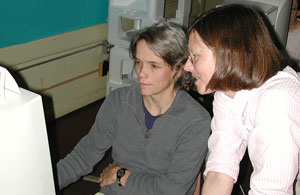|
HOME | SEARCH | ARCHIVE |
|
An educational partnership is turning kids into comet makers and earthquake predictors
By Diane Ainsworth, Public Affairs
| |
|
15 NOVEMBER 00 | How do you become a fossil? And stay a fossil? What was the Earth like 4 billion years ago? Why do earthquakes strike in certain places? What is Europe's largest glacier? How do you "make" a comet?
Kids in the San Francisco Unified School District are going online to explore these questions in a model Berkeley educational outreach program designed to bridge the digital divide and raise science comprehension among middle and high school students.
Integrating Science, Teaching, and Technology, one of the Interactive University's 11 projects, is a unique partnership between four campus units and San Francisco schools to develop a variety of inquiry-based digital science materials for use in the classroom.
But it's not just the students who have benefited from this collaboration, said Judy Scotchmoor, project coordinator for the program and director of education and public programs in Berkeley's Museum of Paleontology, one of the four campus participants.
"We've developed some wonderful partnerships with the San Francisco schools," she said. "With the new emphasis on earth and space sciences in the district, our work with the science teachers has helped them to structure their courses around the district's new content and performance standards and has helped them feel more confident about teaching the subjects."
Along with three other units - the Berkeley Seismological Laboratory, the Center for Particle Astrophysics and the Center for Science Education at Space Sciences Laboratory - the team has produced some of the most imaginative and engaging science classes and teacher workshops around.
During the summer of 1999, approximately 1200 incoming ninth-grade students in a program called Summer Step-Up had a virtual university of online tools and data about the universe, earthquakes, volcanoes, geology and paleontological collections to assist them in lessons about the natural world. San Francisco was so pleased with the results that it asked for resources again for Summer Step-Up 2000.
"For the teachers, it was an opportunity to test new earth and space science materials that they could use during the regular school year," said Colleen Whitney, a team member working at the Museum of Paleontology. "For us, it was working with the teachers, which gave us a chance to test new educational modules and get feedback about their effectiveness in a variety of classroom situations."
The project team has worked with as many as eight teachers at four schools - Horace Mann Middle School, Mission High School, the Galileo Academy of Science and Technology and Thurgood Marshall High School - to deliver innovative, hands-on and online materials, including a rich inventory of digital data and images, to the classroom.
In a program developed by the Berkeley Seismological Laboratory, students are able to study earthquakes and apply their knowledge to new temblors making the news. Seismologist Lind Gee spends part of her time following quakes and building lessons around each new shaker.
"I enjoy structuring activities around current events and talking to people about earthquakes," Gee said. "The teachers always give me more ideas for developing new online activities."
She designed a full menu of activities around the recent Sept. 3 quake in Yountville. Background information, maps and seismograms have been posted, as well as links to Web pages that allow students to make their own maps of earthquake faults and likely hot spots, by plotting coordinates on a U.S. Geological Survey grid.
"We try to take advantage of a teachable moment by providing relevant materials when an earthquake, volcano or some other earth science event is in the news," Gee said. "We act like a clearinghouse for them in finding the best informational sites so they don't spend hours searching."
To complement an online course on comets, scientists from the Space Sciences Laboratory showed up at Horace Mann Middle School in May with nearly 60 pounds of dry ice, mixing bowls, plastic bags and other ingredients to show sixth-grade students the art of making comets.
Donning their "Bill
Nye the Science Guy" chef's hats and aprons, the scientists pulled out
mixing bowls and added dry ice, water, ammonia and dirt to create their
very own comets-in-a-bowl. At the end of the demonstration, the class
convened in the school computer lab to take a lesson online from "The
Comet's Tail," an information-rich resource developed by the Space Sciences
Laboratory's Center for Science Education, which explores the origins,
characteristics and orbits of comets.
Home | Search | Archive | About | Contact | More News
Copyright 2000, The Regents of the University of California.
Produced and maintained by the Office of Public Affairs at UC Berkeley.
Comments? E-mail berkeleyan@pa.urel.berkeley.edu.
